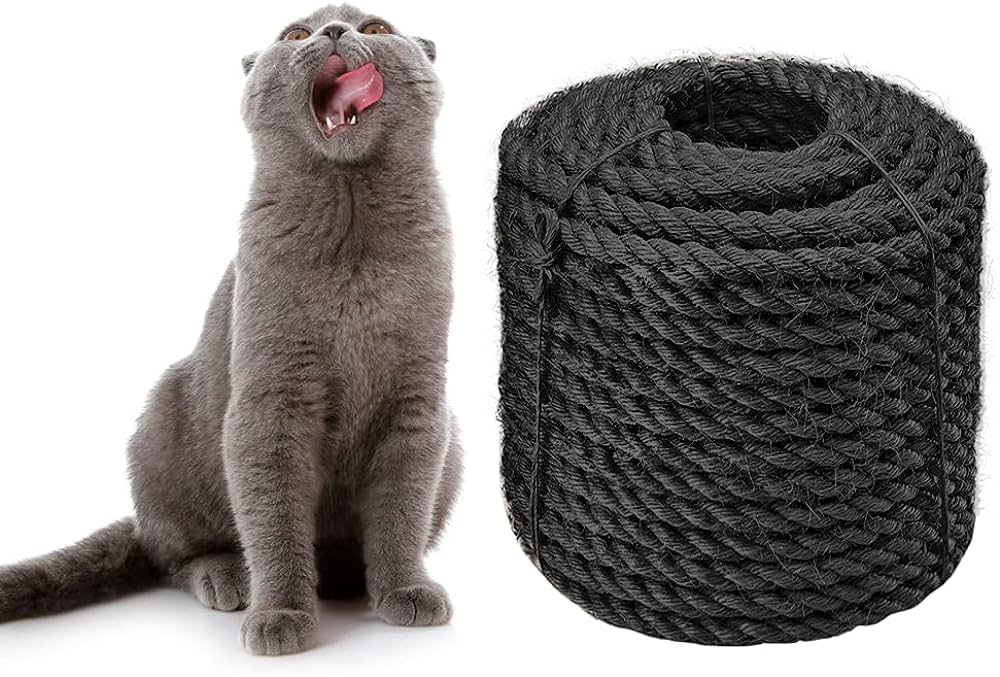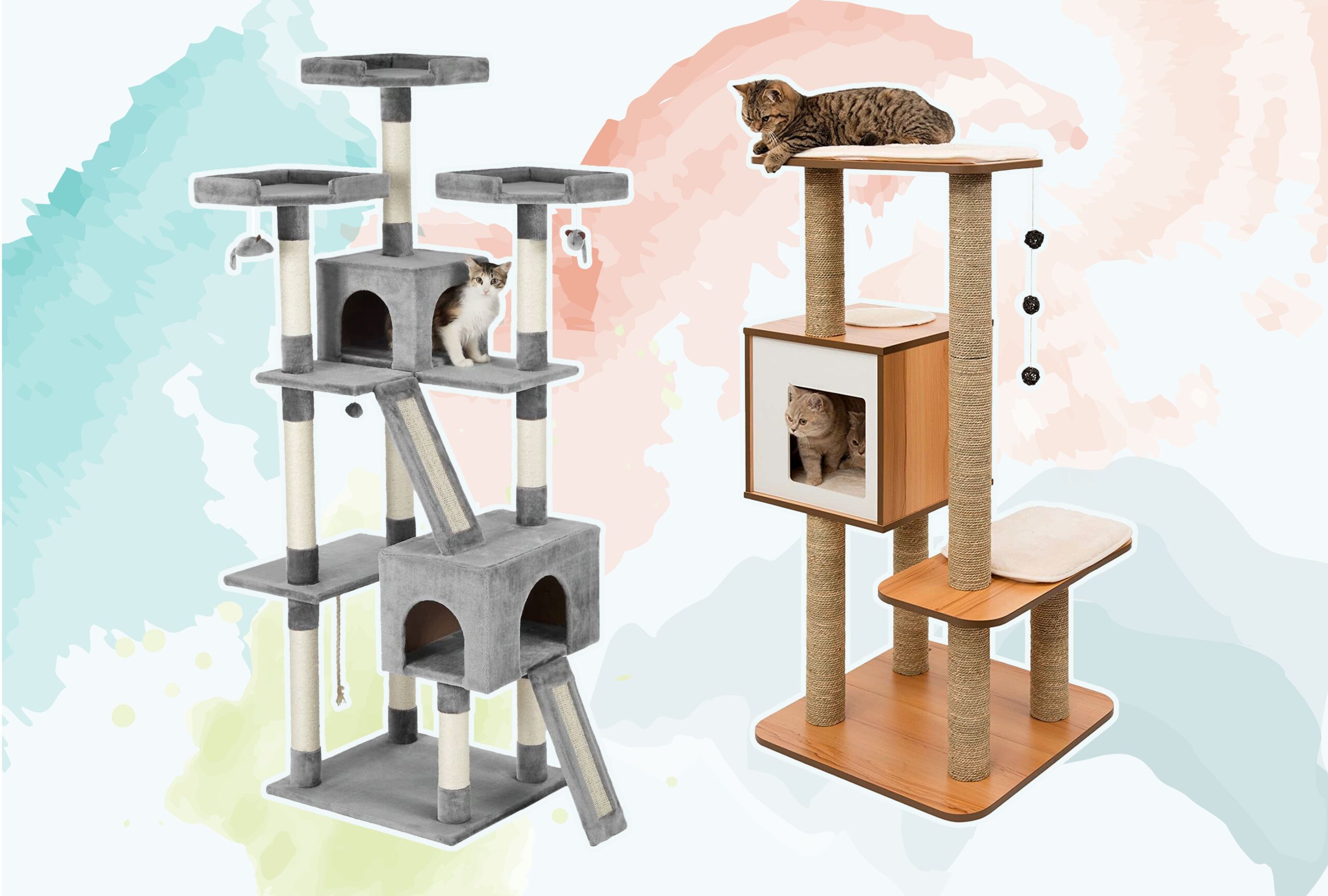To prevent your cat tree from tipping over, anchor it to a wall or choose a base-heavy model. Ensure the tree is on a flat, stable surface to maintain balance.
Cat owners cherish the sight of their feline friends perched high atop a cat tree, but safety always comes first. A sturdy cat tree not only provides a safe playground for cats but also peace of mind for their humans.
Tipping can result from vigorous play or simply from the cat’s weight if the tree is not designed to accommodate it. Ensuring stability involves both the selection of the right cat tree and proper placement within your home. A secure cat tree gives your pet a dedicated space for scratching, climbing, and surveying their domain without the risk of injury or damage to furniture. With the right choice and setup, a cat tree can be a delightful and lasting addition to your pet’s environment.

Credit: www.costco.com
The Risks Of A Tippy Cat Tree
Cat trees offer fun and exercise for our feline friends. Yet, a unstable cat tree can pose dangers. Understanding these risks is key for cat safety and home care.
Safety Concerns For Cats
Cats love to climb and explore. A shaky cat tree might fall, causing injuries. Cats can get their claws caught or jump poorly due to instability. Here are some things to consider for cat safety:
- Stable base: Ensure the tree’s base is wide and heavy.
- Proper size: Match the tree’s size with your cat’s weight.
- Regular checks: Tighten loose parts often.
Potential Damage To Your Home
Not only can cats get hurt, your home can suffer too. An overturning cat tree can break valuables. Wall damage can also occur from falling trees. Here’s how to protect your home:
- Position wisely: Place away from fragile items.
- Secure to a wall: Use brackets or anchors if needed.
- Surface check: Choose a flat, even surface for the tree.
Ensuring firm setup decreases these risks. Always choose quality cat trees for peace of mind.
Types Of Cat Trees And Stability Factors
Choosing the right cat tree for your furry friend involves understanding the various designs and identifying key stability factors. A sturdy cat tree provides a safe place for your cat to play, climb, and rest. Let’s explore the different types and what makes them stable.
Various Cat Tree DesignsVarious Cat Tree Designs
Cat trees come in shapes and sizes suited for all spaces and feline friends.
- Traditional Towers – Tall with multiple levels
- Condo Cat Trees – Include cozy cubbies for hiding
- Wall-Mounted Options – Save floor space, attach to walls
- Scratching Post Hybrids – Combine play area with scratching needs
- Theme-Based Trees – Creative designs, from simple to elaborate
Key Stability Features To Look For
Ensuring your cat’s tree stays upright is vital. Look for these stability-boosting features:
| Stability Feature | Description |
|---|---|
| Wide Base | Helps distribute weight evenly |
| Heavy-Duty Materials | Adds heft and anchors the tree |
| Low Center of Gravity | Keeps the tree from wobbling |
| Wall Anchors | Extra security for tall structures |
| Anti-Tip Straps | Prevents tipping during lively play |
Location Matters: Where To Place Your Cat Tree
Cat trees provide essential vertical space for your feline friends. Choosing the right spot is crucial for their safety and your peace of mind. Not all places in a home suit a cat tree. Let’s explore how to secure the perfect location for your cat’s lofty adventures without risking unwanted tip-overs.
Ideal Spots For Maximum Stability
Look for a place that’s both cat-friendly and steady. The goal is to offer your cat a fun area without accidents. Consider these options:
- Corner placement: Tucking the cat tree into a corner adds extra support on two sides.
- Near furniture: Position next to a couch or bed to prevent wobbling.
- Against a wall: Anchoring one side to a wall can help stabilize the structure.
- On a flat surface: Ensure the base sits on even ground to stop tipping.
Areas To Avoid
Some zones in your home might seem appealing to your cat but are not ideal for a cat tree.
| Area | Reason to Avoid |
|---|---|
| Near doors: | Can cause the tree to move each time the door is used. |
| High traffic areas: | Risk of being bumped into, leading to instability. |
| Carpet edges: | Uneven surfaces may make the base unsteady. |
| Isolated spaces: | Cats might ignore the tree if it’s out of the action. |

Credit: www.amazon.com
Securing The Cat Tree Properly
Keeping your cat tree stable is vital for the safety of your playful feline friend. A well-secured cat tree prevents accidents and ensures your pet can leap and play without worry. Follow these essential steps to keep your cat tree from toppling over.
Anchoring To The Wall
An effective method to prevent the cat tree from tipping is to anchor it to a wall. Here’s a simple guide:
- Locate wall studs using a stud finder.
- Align the cat tree with the studs for support.
- Use brackets or straps to connect the tree to the studs.
- Secure tightly with appropriate screws or fasteners.
- Regularly check for stability and make adjustments if needed.
Using Weighted Bases
Weighted bases add balance to your cat tree, ensuring it stays upright. Below are steps to enhance your cat tree with weighted bases:
- Select a base that fits the bottom of your cat tree.
- Choose materials like sandbags or weights to add heft.
- Place the weights evenly around the base.
- Ensure attachments do not obstruct your cat’s movements.
- Test the stability by gently pushing the tree in various directions.
Diy Solutions For Extra Support
Keeping a cat tree from tipping over is important. Cats love to climb and play, and their safety is paramount. DIY solutions can add extra support to cat trees. These solutions are simple and can be made with items found at home or a local store. Let’s reinforce that cat tree together!
Homemade Stabilizers
Bolstering the stability of a cat tree can be easy and cost-effective. Start by identifying areas that need reinforcement. Look for loose joints or weak spots. Use wood or metal brackets to secure these areas. Use screws to attach them firmly. Make sure all materials are non-toxic and safe for felines. Added stabilizers ensure the cat tree stays upright, keeping your cat safe during play.
Adding Weight To The Base
A heavy base is key to a stable cat tree. An easy fix is to add weight to the existing base. Items such as sandbags, standard weights, or even books can serve this purpose. Arrange weights evenly around the base. Secure them properly to prevent slipping or shifting. A weighted base reduces the risk of the cat tree tipping over.
| Material | Placement | Type of Weight |
|---|---|---|
| Sandbags | Perimeter of Base | Flexible |
| Standard Weights | Center of Base | Heavy and Compact |
| Books | Spread Evenly | Customizable |
Routine Maintenance And Checks
Keeping your cat tree stable not only ensures your cat’s safety but also extends the life of the tree. Regular maintenance and checks are crucial in preventing your cat’s favorite playground from becoming a hazard. In this section, we’ll look at how simple, routine upkeep can keep your furry friend’s tree steady and secure.
Regular Inspections For Wear And Tear
Inspect your cat tree often to avoid unexpected tipping. Look for signs of damage such as:
- Loose screws – Tighten them promptly.
- Frayed ropes – Replace if necessary.
- Wobbling parts – Secure or mend immediately.
Keep an eye on the stability of the base. Check all parts of the structure for any weaknesses.
When To Replace Your Cat Tree
Knowing when to get a new cat tree is important for safety. Consider replacement:
- If repairs are frequent.
- When wear is extensive.
- If the tree is older than five years.
Choose a sturdy, high-quality replacement to prevent future tipping. Make sure it matches your cat’s size and activity level.

Credit: www.amazon.com
Frequently Asked Questions For How To Keep Cat Tree From Tipping Over
Why Do Cat Trees Fall Over?
Cat trees can fall over due to unstable bases, excessive weight at the top, or overly energetic cats. Ensuring a sturdy, well-balanced design and proper anchoring can prevent this issue, enhancing safety for your feline friends.
How Can You Stabilize A Wobbly Cat Tree?
Stabilizing a wobbly cat tree involves securing it to a wall using brackets or adding weight to the base. Check for loose components and retighten them. Providing a broader or heavier base can also increase stability significantly.
What Materials Make Cat Trees More Stable?
Heavier materials like solid wood or engineered wood provide greater stability for cat trees. Avoid lightweight plastics or thin particle board. A thick carpet or sisal-covered base adds weight and stability to prevent tipping.
Can Anchoring Cat Trees Damage Walls?
Anchoring cat trees can cause minor damage to walls, such as screw holes. However, using proper wall anchors and careful installation minimizes impact. Consider wall repair kits for an easy fix upon removal.
Conclusion
Securing your cat tree is paramount for your feline’s safety and your peace of mind. With the tips outlined, you’ll ensure stability and durability. Remember, a sturdy cat tree equals a happy, agile cat. Take action today for a safer playtime tomorrow!


